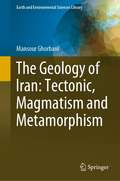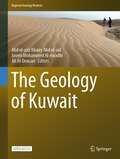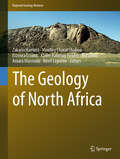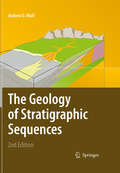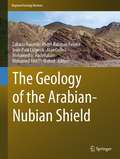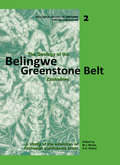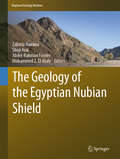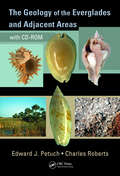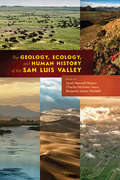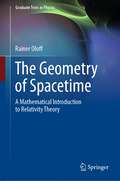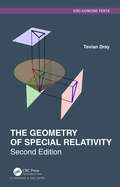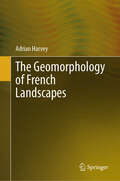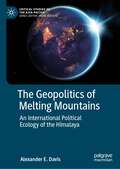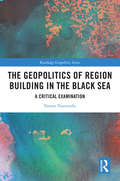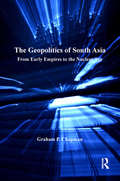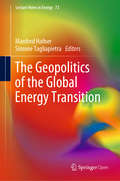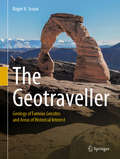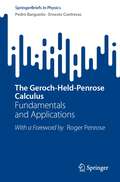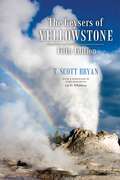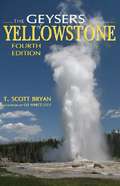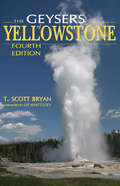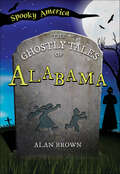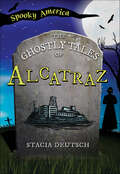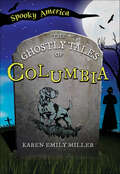- Table View
- List View
The Geology of Iran: Tectonic, Magmatism and Metamorphism (Earth and Environmental Sciences Library)
by Mansour GhorbaniThis book describes the geological setting of Iran throughout geological history, referring to paleogeography and general geodynamics. Also, all structural units, faults, tectonic phases and orogeny occurred in the geology of Iran have been evaluated. Magmatic and metamorphic rocks along with ophiolitic complexes have extensive outcrops in Iran, and these rocks with Precambrian age constitute its basement. Study and identification of such rocks not only throws light on the geodynamic issues of Iran but also helps in recognition of the mode of formation and evolution of the sedimentary basins located within various structural divisions of the country. Moreover, the majority of metallic and non-metallic mineral deposits are associated either directly or indirectly with magmatic, and at time metamorphic, rocks. In the Magmatism and Metamorphism parts, it is tried to thoroughly consider the various aspects of the igneous rocks, whether intrusive, extrusive or young volcanoes, from the point of view of petrography, geochemistry and geodynamics. In addition, the major intrusive bodies of Iran have been presented along with their petrologic and chronologic specifications in tables, mentioning the bibliographic resources.
The Geology of Kuwait (Regional Geology Reviews)
by Ali Al-Dousari Abd el-aziz Khairy Abd el-aal Jasem Mohammed Al-AwadhiThis open access book contains a set of chapters covering all aspects of geosciences related to Kuwait and adjacent regions, including Iran, Saudi Arabia and the Arab Gulf states. It covers basic information about the geology including a wide range of geoscientific disciplines such as marine geology, structural geology, hydrogeology and geophysics related to the region. This book is aimed at researchers and students, as well as professionals in the field of hazard mitigation and petroleum exploration.
The Geology of North Africa (Regional Geology Reviews)
by Ezzoura Errami Zakaria Hamimi Abdel-Rahman Fowler Moulley Charaf Chabou Nuri Fello Amara Masrouhi Rémi LeprêtreThis richly illustrated book reviews the geology, tectonics, sedimentary basins and strategic resources of North Africa in 21 chapters. Chapter 1 is a regional synthesis. Chapter 2 examines the deep crustal and upper mantle structure. Chapter 3 compares the West African Craton. Chapters 4,5,6,7 deal with Pan-African-, Variscan (Hercynian)- and Alpine-Belts. Precambrian Geology of Hoggar Shield, north Central Africa will be addressed in Chapter 8. The North African Neoproterozoic and Phanerozoic sedimentary basins are the topic of Chapter 9. Phanerozoic magmatism and geodynamic framework of North Africa are addressed in Chapter 10. Chapters 11,12 deal with petroleum geology and water resources. Important non-metallic- and metallic- ore deposits are presented in Chapter 13,14,15,16. Chapters 17,18 explore geothermal energy and other strategic resources. Chapters 19,20 discuss seismicity, seismotectonics and Neotectonics, and Advances of exploration geophysics in North Africa. The lasttwo chapters (20, 21) focus on meteoric impact craters, geoheritage, geoparks and geotourism in North Africa.
The Geology of Stratigraphic Sequences
by Andrew D. MiallIt has been more than a decade since the appearance of the First Edition of this book. Much progress has been made, but some controversies remain. The original ideas of Sloss and of Vail (building on the early work of Blackwelder, Grabau, Ulrich, Levorsen and others) that the stratigraphic record could be subdivided into sequences, and that these sequences store essential information about basin-forming and subsidence processes, remains as powerful an idea as when it was first formulated. The definition and mapping of sequences has become a standard part of the basin analysis process. The main purpose of this book remains the same as it was for the first edition, that is, to situate sequences within the broader context of geological processes, and to answer the question: why do sequences form? Geoscientists might thereby be better equipped to extract the maximum information from the record of sequences in a given basin or region. Tectonic, climatic and other mechanisms are the generating mechanisms for sequences ranging over a wide range of times scales, from hundreds of millions of years to the high-frequency sequences formed by cyclic processes lasting a few tens of thousands of years
The Geology of the Arabian-Nubian Shield (Regional Geology Reviews)
by Zakaria Hamimi Alan Collins Abdel-Rahman Fowler Jean-Paul Liégeois Mohamed G. Abdelsalam Mohamed Abd EI-WahedThis richly illustrated book reviews the geology, tectonics and mineralization of the Arabian-Nubian Shield (ANS) in 27 chapters. It starts with an examination of the ANS lithospheric scale features, explores Mesoproterozoic units and deals with the ANS oceanic stage. Arc volcanism and plutonism, post-collision basins and volcanics are discussed, as well as the younger granitoid magmatism and the deformation history of the ANS. The book provides information on ANS glacial stages and late magmatism. Chapters are devoted to review the transition between ANS and the reworked continent to its south. Finally, it discusses how ANS structures influenced the overall East African Rift System.
The Geology of the Belingwe Greenstone Belt, Zimbabwe: A study of Archaean continental crust
by A. Martin M.J. Bickle E.G. Nisbet J.L. OrpenA study on the Bellingwe Greenstone Belt, presenting the stratigraphy of the belt, its structure and tectonic setting, the sedimentology of what may be a rift basin, the geochemistry of the freshest Archaean komatiites yet found, and models of the evolution of the region.
The Geology of the Egyptian Nubian Shield (Regional Geology Reviews)
by Zakaria Hamimi Shoji Arai Abdel-Rahman Fowler Mohammed Z. El-BialyThis richly illustrated book provides an overview of the Neoproterozoic Pan-African Belt of Egypt (PABE), which represents the northwestern continuation of the Arabian-Nubian Shield (ANS) and the East African Orogen (EAO). The first chapter offers an introduction to the Turin Papyrus Map and the historical background of the PABE, while the second addresses how the PABE is related to the ANS and EAO. Rock succession of the PABE is dealt with in Chapter 3, while Chapter 4 focuses on Sinai Metamorphic Core Complexes and implications on the break-up of Rodinia. Subsequent chapters discuss a broad range of topics, e.g. ophiolite-dominated suprastructural rocks; volcanosedimentary succession, Neoproterozoic volcanism and volcanic rocks in Egypt; enigmatic issues concerning granite, Dokhan and Hammamat sediments; the lithospheric mantle beneath the Northeast African continent and the mantle section of Neoproterozoic ophiolites from the PABE; sutures, megashears and petrogenetic evolution of the Neoproterozoic rocks of Egypt; and metallic and non-metallic mineral deposits in the PABE, which are covered in extensive detail. The book’s closing chapters discuss the application of remote sensing techniques and anisotropy of magnetic susceptibility (AMS) to decipher the tectonic evolution of the PABE, as well as the use of geophysical data to map structural features and hydrothermal alteration zones in the PABE.
The Geology of the Everglades and Adjacent Areas
by Charles Roberts Edward J. PetuchPainting a complete picture of the history of the Everglades, The Geology of the Everglades and Adjacent Areas brings together theperspectives of various geoscientists to provides an overview of the geology, paleontology, and paleoceanography of the Everglades region. It emphasizes the upper 300 m of the geologic framework of the area and gives insight into the local stratigraphy, geomorphology, lithology, and historical geology. Building upon the geologic nomenclature and stratigraphic sequences set down by the Florida Geological Survey, the book includes redefinitions of some previously poorly known formations, the chronological fine-tuning of other poorly known units, and the description of 7 new members.Designed to be a field guide as well as a reference, the book is illustrated with photographs of exposed geologic sections, stratotype localities, collection sites, and details of interesting fossil beds. It contains 124 full-page illustrations with 69 black and white figures, 43 black and white plates of index fossils, and 12 full color plates of simulated space shuttle images of Florida’s ancient seas and coastlines. This text is accompanied by downloadable resources that feature animated maps along with a Power Point presentation of simulated space shuttle imagery of Eocene-to-Holocene Florida. The book is arranged by geologic time, ranging from the late Eocene, Oligocene, Miocene, Pliocene, and Pleistocene to the Holocene. The authors place lithostratigraphic descriptions of the geologic formations and members into this chronological framework, along with the paleogeography of the seas and lakes within which they were deposited. They also emphasize biostratigraphy with over 1000 index fossils listed and over 400 illustrated. The book brings together information previously spread through innumerable publications, saving you the time and effort it would take to assemble and cross-reference multiple sources.
The Geology, Ecology, and Human History of the San Luis Valley
by Jared Maxwell Beeton Charles Nicholas Saenz Benjamin James WaddellThe Geology, Ecology, and Human History of the San Luis Valley explores the rich landscapes and diverse social histories of the San Luis Valley, an impressive mountain valley spanning over 9,000 square miles that crosses the border of south-central Colorado and north-central New Mexico and includes many cultural traditions. Twenty-six expert scholars and educators—including geologists, geographers, biologists, ecologists, linguists, historians, sociologists, and consultants—uncover the natural and cultural history of the region, which serves as home to the Sangre de Cristo Mountains, the San Juan Mountains, Great Sand Dunes National Park and Preserve, and the Rio Grande headwaters. The first section, “The Geology and Ecology of the San Luis Valley,” surveys the geomorphology, hydrology, animal and plant life, conservation, management, and mining of the valley’s varied terrain. The second section, “Human History of the San Luis Valley,” recounts the valley’s human visitation and settlement, from early indigenous life to Spanish exploration to Hispanic and Japanese settlements. This section introduces readers to the region’s wide range of religious identities—Catholic, Latter-day Saint, Buddhist, Jehovah’s Witness, Amish, and Mennonite—and diverse linguistic traditions, including Spanish, English, Dutch, Danish, Japanese, and Mayan. The final section, “Travel Itineraries,” addresses recreation, specifically fly-fishing and rock climbing. The book provides a comprehensive overview of the endemic flora and fauna, human history of indigenous lifeways, and diverse settlement patterns that have shaped the region. The Geology, Ecology, and Human History of the San Luis Valley will appeal to students and scholars of geology, ecology, environmental history, and cultural history, as well as residents and tourists seeking to know more about this fascinating and integral part of Colorado and New Mexico. Contributors: Benjamin Armstrong, Timothy Armstrong, Deacon Aspinwall, Robert Benson, Lorrie Crawford, Kristy Duran, Jeff Elison, Eric Harmon, Devin Jenkins, Bradley G. Johnson, Robert M. Kirkham, Bessie Konishi, Angie Krall, Richard D. Loosbrock, Richard Madole, A. W. Magee, Victoria Martinez, James McCalpin, Mark Mitchell, R. Nathan Pipitone, Andrew Valdez, Rio de la Vista, Damián Vergara Wilson
The Geometry of Physics
by Theodore FrankelThis book provides a working knowledge of those parts of exterior differential forms, differential geometry, algebraic and differential topology, Lie groups, vector bundles and Chern forms that are essential for a deeper understanding of both classical and modern physics and engineering. Included are discussions of analytical and fluid dynamics, electromagnetism (in flat and curved space), thermodynamics, the Dirac operator and spinors, and gauge fields, including Yang–Mills, the Aharonov–Bohm effect, Berry phase and instanton winding numbers, quarks and quark model for mesons. Before discussing abstract notions of differential geometry, geometric intuition is developed through a rather extensive introduction to the study of surfaces in ordinary space. The book is ideal for graduate and advanced undergraduate students of physics, engineering or mathematics as a course text or for self study. This third edition includes an overview of Cartan's exterior differential forms, which previews many of the geometric concepts developed in the text.
The Geometry of Spacetime: A Mathematical Introduction to Relativity Theory (Graduate Texts in Physics)
by Rainer OloffThis book systematically develops the mathematical foundations of the theory of relativity and links them to physical relations. For this purpose, differential geometry on manifolds is introduced first, including differentiation and integration, and special relativity is presented as tensor calculus on tangential spaces. Using Einstein's field equations relating curvature to matter, the relativistic effects in the solar system including black holes are discussed in detail. The text is aimed at students of physics and mathematics and assumes only basic knowledge of classical differential and integral calculus and linear algebra.
The Geometry of Special Relativity (Textbooks in Mathematics)
by Tevian DrayThis unique book presents a particularly beautiful way of looking at special relativity. The author encourages students to see beyond the formulas to the deeper structure.The unification of space and time introduced by Einstein’s special theory of relativity is one of the cornerstones of the modern scientific description of the universe. Yet the unification is counterintuitive because we perceive time very differently from space. Even in relativity, time is not just another dimension, it is one with different propertiesThe book treats the geometry of hyperbolas as the key to understanding special relativity. The author simplifies the formulas and emphasizes their geometric content. Many important relations, including the famous relativistic addition formula for velocities, then follow directly from the appropriate (hyperbolic) trigonometric addition formulas.Prior mastery of (ordinary) trigonometry is sufficient for most of the material presented, although occasional use is made of elementary differential calculus, and the chapter on electromagnetism assumes some more advanced knowledge.Changes to the Second Edition The treatment of Minkowski space and spacetime diagrams has been expanded. Several new topics have been added, including a geometric derivation of Lorentz transformations, a discussion of three-dimensional spacetime diagrams, and a brief geometric description of "area" and how it can be used to measure time and distance. Minor notational changes were made to avoid conflict with existing usagein the literature. Table of Contents Preface1. Introduction.2. The Physics of Special Relativity.3. Circle Geometry.4. Hyperbola Geometry. 5. The Geometry of Special Relativity. 6. Applications.7. Problems III.8. Paradoxes.9. Relativistic Mechanics.10. Problems II.11. Relativistic Electromagnetism. 12. Problems III.13. Beyond Special Relativity. 14. Three-Dimensional Spacetime Diagrams.15. Minkowski Area via Light Boxes.16. Hyperbolic Geometry.17. Calculus.Bibliography. Author Biography Tevian Dray is a Professor of Mathematics at Oregon State University. His research lies at the interface between mathematics and physics, involving differential geometry and general relativity, as well as nonassociative algebra and particle physics; he also studies student understanding of "middle-division" mathematics and physics content. Educated at MIT and Berkeley, he held postdoctoral positions in both mathematics and physics in several countries prior to coming to OSU in 1988. Professor Dray is a Fellow of the American Physical Society for his work in relativity, and an award-winning teacher.
The Geomorphology of French Landscapes
by Adrian HarveyThis richly illustrated book provides a regionally focused overview about the landscapes and landforms of France. It is divided into two parts: the first chapters deal with the broad geology and geomorphology in the context of the present geomorphology of France. The second part provides a regionally-based treatment of the more detailed geomorphology. The book is aimed to an academic readership, as well as interested laymen.
The Geopolitics of Melting Mountains: An International Political Ecology of the Himalaya (Critical Studies of the Asia-Pacific)
by Alexander E. DavisThe book addresses the urgent need for rethinking the geopolitics and ecology in the Himalaya, by emphasising the entanglements between these two factors. Most international relations analyses of the Himalaya emphasize the central role of the region’s states and their great power struggles. By reducing the region to its state actors, however, we miss the intense more-than-human diversity of the region, and the crucial role that the mountains play in the global environment. In doing so, the book makes a major contribution to international relations theory by drawing on insights from international political ecology. It first theorises international political ecology and examines the Himalaya as a global region, before moving looking at the international aspects of political ecology in the Himalaya through key areas of the mountains where international politics and ecology are deeply, inextricably linked. It presents three detailed case studies of different environmental and political issues in the Himalaya: icecaps (the India-China-Pakistan boundary dispute in the western Himalaya), foothills and forests (the Nepal-Bhutan-Sikkim borderlands), and rivers (the India-China Bangladesh dispute over the Brahmaputra River basin). Each case study draws on a mix of source materials including fieldwork, government sources, foreign policy discourse, Himalayan ethnographies, and environmental and ecological sciences scholarship.
The Geopolitics of Region Building in the Black Sea: A Critical Examination (Routledge Geopolitics Series)
by Yannis TsantoulisOffering theoretical insights on region building, this book explores the attempts to formulate a political and institutional vision for the Black Sea region in the post-9/11 era and in the context of the enlargements of the EU and NATO. It investigates in depth these attempts, viewed as a failure by the key actors involved, in order to understand how regions emerge in international politics as well as how and why they may fail to come into being. To this end, the book explores a range of factors that impacted region building in the Black Sea, considering the role of region builders involved, their practices and the context of their actions, and the spatial representations and security discourses that were integral to the region building process. Hence, attention is paid to how these factors both enabled and constrained the discursive construction of the Black Sea region, thus identifying the elements that distinguish the Black Sea from other successful cases of region building. Based on critical approaches towards international relations and political geography, this book both expands and deepens the scope and understanding of regions and will thus appeal to academics and students in the fields of International Relations, Security Studies, Political Geography, and Regional Integration.
The Geopolitics of South Asia: From Early Empires to the Nuclear Age (Routledge Revivals Ser.)
by Graham P. ChapmanAnyone who is planning on carrying out research in South Asia or indeed anyone who simply wishes to understand more about this cultural heartland should read this book. It shows how geological movements moulded the land of this unique cradle and how they still impact on it. Discussions are woven around the three major forces of integration. These are 'identitive' forces - bonds of language, ethnicity, religion or ideology; 'utilitarian' forces - bonds of common material interest, and 'coercion' - the institutional use or threat of physical violence. By studying these forces, Professor Chapman shows how the organization of territory has been central to the region's historic, cultural, linguistic and economic development. In addition to the material on the Northwest frontier, Afghanistan and Kashmir which was added for the second edition, the Northeastern borderlands are also now examined in this fully revised third edition. The current geopolitical state of the region is completely updated and greatly enhanced.
The Geopolitics of the Global Energy Transition (Lecture Notes in Energy #73)
by Simone Tagliapietra Manfred HafnerThe world is currently undergoing an historic energy transition, driven by increasingly stringent decarbonisation policies and rapid advances in low-carbon technologies. The large-scale shift to low-carbon energy is disrupting the global energy system, impacting whole economies, and changing the political dynamics within and between countries. This open access book, written by leading energy scholars, examines the economic and geopolitical implications of the global energy transition, from both regional and thematic perspectives. The first part of the book addresses the geopolitical implications in the world’s main energy-producing and energy-consuming regions, while the second presents in-depth case studies on selected issues, ranging from the geopolitics of renewable energy, to the mineral foundations of the global energy transformation, to governance issues in connection with the changing global energy order. Given its scope, the book will appeal to researchers in energy, climate change and international relations, as well as to professionals working in the energy industry.
The Geotraveller: Geology of Famous Geosites and Areas of Historical Interest
by Roger N. ScoonThis book describes famous geosites and historical localities in national parks and conservation areas from North America, East Africa, and Europe. The geosites include iconic landforms associated with active volcanoes, canyons, glaciated landscapes, natural rock monoliths, and rifts. The potential for geotourism in historical localities such as the famous Greco-Roman antiquities of Greece, Italy, and Turkey, is emphasised.Some of the geosites and historical localities provide evidence that previous civilizations coped with active geology and major climatic cycles, whilst others reveal evidence of famous geological events recognized in history and ancient mythology that helped shape our current civilization.The book assists tour guides and visitors (both geologists and non-specialists) interested in geotourism by providing an understanding of geological processes in the national parks and historical locations with the assistance of photographs and simplified geological maps.
The Geroch-Held-Penrose Calculus: Fundamentals and Applications (SpringerBriefs in Physics)
by Pedro Bargueño Ernesto ContrerasThis book offers a primer on the fundamentals and applications of the Geroch-Held-Penrose (GHP) calculus, a powerful formalism designed for spacetimes that occur frequently in the teaching of General Relativity. Specifically, the book shows in detail the power of the calculus when dealing with spherically symmetric spacetimes. After introducing the basics, a new look at all the classical spherically symmetric black hole solutions is given within the GHP formalism. This is then employed to give new insights into the Tolman-Oppenheimer-Volkoff equations for stellar structure, including a derivation of new exact anisotropic fluid solutions. Finally, a re-writing of some essential features of black hole thermodynamics within the GHP formalism is performed. The book is based on the authors' lecture notes, used in their undergraduate and graduate lectures and while supervising their upper undergraduate and graduate students. To fully benefit from this concise primer, readers only need an undergraduate background in general relativity.
The Geysers of Yellowstone, Fifth Edition
by T. Scott BryanThis new edition of The Geysers of Yellowstone is the most up-to-date and comprehensive reference to the geysers of Yellowstone National Park, describing in detail each of the more than five hundred geysers in the park. The entire text has been revised and geyser descriptions have been updated based on activity observed through early 2018. Information about a number of significant new geyser developments has been added, as well as recent knowledge about some of the world’s geyser fields outside Yellowstone. Both a reference work and a fine introduction to the nature of geyser activity, this popular field guide includes a glossary of key terms, a comprehensive appendix that discusses other geyser areas of the world, detailed maps of each geyser basin, and tables for easy reference. The Geysers of Yellowstone will continue to serve geyser gazers as well as newcomers to geothermal phenomena for years to come.
The Geysers of Yellowstone, Fourth Edition
by T. Scott BryanThis revised popular field guide describes in detail each of the more than 500 geysers in Yellowstone National Park. With updated information and a new foreword by park archivist Lee Whittlesey, Geysers of Yellowstone is both a reference work and a fine introduction to the nature of geyser activity for the newcomer to geothermal phenomena. A glossary of key terms is provided, along with a comprehensive appendix that discusses other geyser areas of the world. Detailed maps accompany each geyser basin described, and tables are provided for easy reference.
The Geysers of Yellowstone, Fourth Edition
by T. Scott BryanThis revised popular field guide describes in detail each of the more than 500 geysers in Yellowstone National Park. With updated information and a new foreword by park archivist Lee Whittlesey, Geysers of Yellowstone is both a reference work and a fine introduction to the nature of geyser activity for the newcomer to geothermal phenomena. A glossary of key terms is provided, along with a comprehensive appendix that discusses other geyser areas of the world. Detailed maps accompany each geyser basin described, and tables are provided for easy reference.
The Ghostly Tales of Alabama (Spooky America)
by Alan BrownGhost stories from America's "Heart of Dixie" have never been so creepy, fun, and full of mystery! Welcome to the spooky state of Alabama! Stay alert! Ghosts lurk around every corner. Even the most unexpected places might be haunted by wandering phantoms. Did you know that every February, a sunken ship rises again on the Tombigbee River? Or that the man peeking out of the Pickens County Courthouse window was wrongfully imprisoned there…150 years ago? Can you believe the sounds of a Civil War horse still echo on the porch of an old house in Suggsville? Pulled right from history, these ghostly tales will change the way you see Alabama and have you sleeping with the light on!
The Ghostly Tales of Alcatraz (Spooky America)
by Stacia DeutschGhost stories from America's most infamous prison have never been so creepy, fun, and full of mystery! Welcome to the spooky island of Alcatraz! Stay alert! Ghosts lurk around every corner. Even the most unexpected places might be haunted by wandering phantoms. Did you know a ghost nurse wanders the halls in search of prisoners to heal? Or that nobody has ever escaped from Alcatraz…and lived to tell the tale? Can you believe Cell 14D is haunted by a mysterious, red-eyed monster? Pulled right from history, these ghostly tales will change the way you see Alcatraz and have you sleeping with the light on!
The Ghostly Tales of Columbia (Spooky America)
by Karen MillerGhost stories from America's heartland have never been so creepy, fun, and full of mystery! Welcome to the spooky streets of Columbia, Missouri! Stay alert! Ghosts lurk around every corner. Even the most unexpected places might be haunted by wandering phantoms. Did you know ghostly soldiers reenact Civil War battles along one road in Woodlandville? Or that a demon pack of hunting dogs can still be heard baying on a haunted farm outside Columbia? Can you believe that in the home of the University president, a former resident decided never to leave? Pulled right from history, these ghostly tales will change the way you see Columbia and have you sleeping with the light on!
